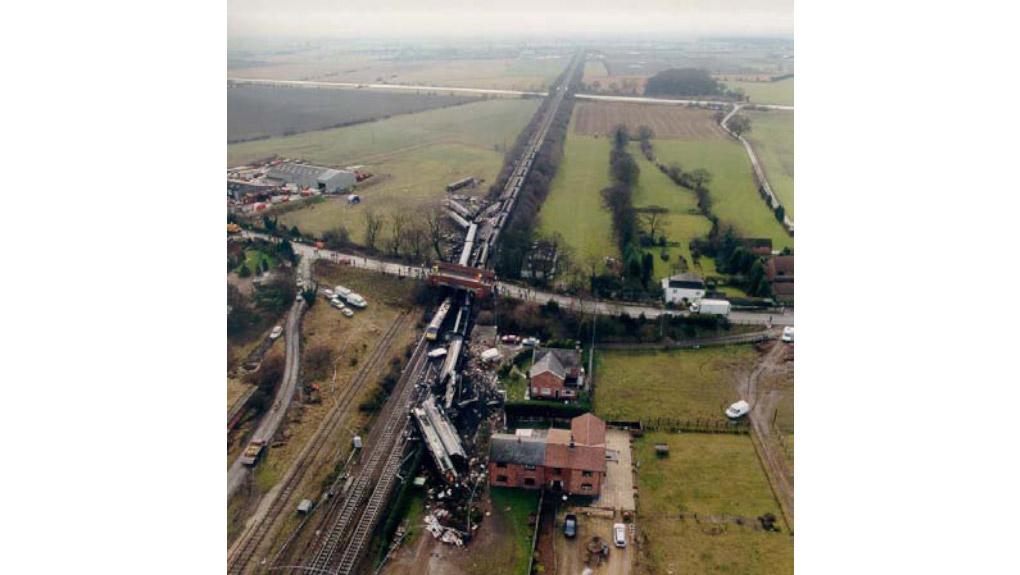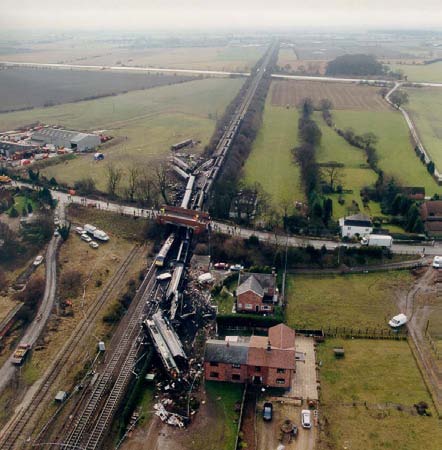
It was Saturday 3 March 2001.
Three days had passed since the morning of 28 February when at approximately 06:13 am, an InterCity 225 passenger train operated by Great North Eastern Railway (GNER) hit a stationary car on the railway track on the East Coast Main Line.
The train, from Newcastle to London King’s Cross, derailed into the path of an oncoming freight train. Ten people lost their lives that day including the drivers of both trains. 82 were seriously injured.
At the time, Her Majesty’s Railway Inspectorate (HMRI) was part of the Health and Safety Executive. We were informed of the incident at 06.55am by telephone from Railtrack Zone Control and initiated emergency call out arrangements. Inspectors were on site by 09.24am.
Inspecting the wreckage
As an HM Inspector of Railways I attended site three days after the incident to support the Principal Inspector. As soon as I passed through the outer cordon it became clear to me just how serious an incident this was.
There was severe damage to all nine of the InterCity 225’s Mark 4 coaches and the Class 66 freight locomotive lost its bogies after impact, with debris of the Driving Van Trailer (DVT) jammed underneath rupturing its fuel tank.
The wreckage of the incident was vast. Locomotives, coaches and wagons were spread over a large area.
I was with a BTP Search Team who had been tasked with clearing an area around the remains of the DVT, which had come to rest some distance from the railway in a grass covered field.
The DVT looked as if it had been through a mangle as it had been practically flattened in the crash. I vividly remember there being a first-class Mark 4 coach, minus its bogies, stood upright alone in the field.
In a quiet but eerie moment I entered the coach and I was immediately struck by the amount of railway documents scattered in the carriage. It was clear railway employees had been in the carriage. I paused for a moment of silence.
Attending meetings
Having worked closely with the BTP Search Team, I was later appointed ‘scribe’ to HMRI Silver Control. This meant I had to attend several meetings.
The human cost of the accident was clear and the BTP Officer leading these meetings stressed that once rail vehicles started to be lifted clear, the possibility of discovering further casualties needed to be considered.
Removal of damaged vehicles commenced on Sunday 4 March and continued until Wednesday 7 March.. On that Wednesday the site was handed back to Railtrack by British Transport Police.
Following repair to the damaged infrastructure the railway was reopened to traffic on Tuesday 13 March.
Investigation findings
Early in the investigation it became apparent that the incident was related to the initial impact with the road vehicle and unlikely to be associated with any failing in respect of Health and Safety legislation by the railway infrastructure controller (Railtrack) or the train operators (GNER and Freightliner).
The railway industry, under the direction of Railway Safety, carried out a formal inquiry into the circumstances of the incident that resulted in a number of recommendations at the time.
At the request of the then Deputy Prime Minister and Secretary of State for the Environment, Transport and the Regions, John Prescott, the Health and Safety Commission also set up a working group to examine obstruction of the railway by road vehicles. The findings were set out in a report of the same name.
During our subsequent investigation no defects were found with the infrastructure, rolling stock or personnel competencies that could have contributed to the outcome of the incident. Details of HMRI’s investigations are contained in a report by HSE at the time.
This was a truly awful accident and my thoughts will always remain with all those in the railway family; the passengers that sadly lost their lives, and with the many that were injured on this tragic day 20 years ago.



